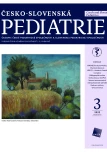Clinical characteristics of patients with a severe course of acute SARS-CoV-2 infection hospitalised in the Department of Paediatrics, University Hospital Motol
Authors:
David Jan; Pešková Šárka; Toni Ledjona; Fencl Filip; Pohunek Petr
Authors‘ workplace:
Pediatrická klinika 2. lékařské fakulty Univerzity Karlovy a Fakultní nemocnice v Motole, Praha
Published in:
Čes-slov Pediat 2022; 77 (3): 175-179.
Category:
Original Papers
Overview
Objective: Although the SARS-CoV-2 infection (COVID-19) is highly contagious, paediatric patients represent only a small proportion of all diagnosed patients. The aim of this study was to assess the clinical characteristics of patients hospitalised with a serious course of acute SARS-CoV-2 infection at the Department of Paediatrics, University Hospital Motol in Prague, Czech Republic.
Methods: We performed a retrospective observational study based on patients hospitalised with acute SARS-CoV-2 infection who were admitted to our department between 1st January 2020 and 1st April 2021. The anonymised data were obtained by medical record review. Serious course criterion was defined as respiratory failure when at least oxygen therapy was needed.
Results: A total of ten patients were hospitalised in our department during the monitored period. The median age was 15 years (range 2-17), predominantly boys (60%). All patients had associated chronic conditions, the most common (60%) being overweight or obesity.
Conclusion: In our experience, comorbid children, especially ones who are obesity or overweight, are at risk of a serious course of acute SARS-CoV-2 infection. This highlights the importance of vaccination for this part of paediatric population as well.
Keywords:
COVID-19 – children – acute infection
Sources
1. Ludvigsson JF. Systematic review of COVID-19 in children shows milder cases and a better prognosis than adults. Acta Paediatr 2020; 109(6): 1088–95.
2. Dhochak N, Singhal T, Kabra SK, et al. Pathophysiology of COVID- 19: Why children fare better than adults? Indian J Pediatr 2020; 87(7): 537–46.
3. Ni W, Yang X, Yang D, et al. Role of angiotensin-converting enzyme 2 (ACE2) in COVID-19. Crit Care 2020; 24(1): 422.
4. Mihalopoulos M, Levine AC, Marayati NF, et al. The resilient child: sex-steroid hormones and COVID-19 incidence in pediatric patients. J Endocr Soc 2020; 4(9): bvaa106.
5. Mehta NS, Mytton OT, Mullins EWS, et al. SARS-CoV-2 (COVID-19): What do we know about children? A systematic review. Clin Infect Dis 2020; 71(9): 2469–79.
6. Williams N, Radia T, Harman K, et al. COVID-19 severe acute respiratory syndrome coronavirus 2 (SARS-CoV-2) infection in children and adolescents: a systematic review of critically unwell children and the association with underlying comorbidities. Eur J Pediatr 2021; 180(3): 689–97.
7. Gunes H. What chances do children have against COVID-19? Is the answer hidden within the thymus? Eur J Pediatr 2021; 180(3): 983–6.
8. Yasuhara J, Kuno T, Takagi H, et al. Clinical characteristics of COVID- 19 in children: A systematic review. Pediatr Pulmonol 2020; 55(10): 2565–75.
9. Jiehao C, Jing X, Daojiong L, et al. A case series of children with 2019 novel coronavirus infection: clinical and epidemiological features. Clin Infect Dis 2020; 71(6): 1547–51.
10. Dong Y, Mo X, Hu Y, et al. Epidemiological characteristics of 2143 pediatric patients with 2019 coronavirus disease in China. Pediatrics 2020. doi: 10.1542/peds.2020-0702
11. Aghagoli G, Gallo Marin B, Katchur NJ, et al. Neurological involvement in COVID-19 and potential mechanisms: a review. Neurocrit Care 2021; 34: 1062–71.
12. Rostad CA, Chahroudi A, Mantus G, et al. Quantitative SARS-CoV-2 serology in children with multisystem inflammatory syndrome (MIS- -C). Pediatrics 2020; 146: e2020018242.
13. Whitworth HB, Sartain SE, Kumar R, et al. Rate of thrombosis in children and adolescents hospitalized with COVID-19 or MIS-C. Blood 2021; 5: blood.2020010218.
14. Centers for Disease Control and Prevention: Covid-19 vaccine effectiveness. Dostupné na: https://www.cdc.gov/coronavirus/ 2019-ncov/vaccines/effectiveness/how-they-work.html
Labels
Neonatology Paediatrics General practitioner for children and adolescentsArticle was published in
Czech-Slovak Pediatrics

2022 Issue 3
- What Effect Can Be Expected from Limosilactobacillus reuteri in Mucositis and Peri-Implantitis?
- The Importance of Limosilactobacillus reuteri in Administration to Diabetics with Gingivitis
Most read in this issue
- Autism spectrum disorders
- Gender incongruence in childhood
- Suicidality and self-harming in childhood and adolescence – actual situation
- Refeeding syndrome
